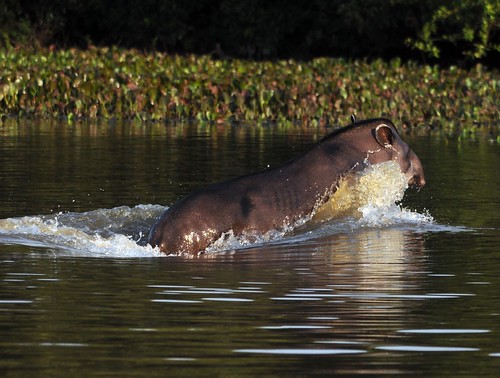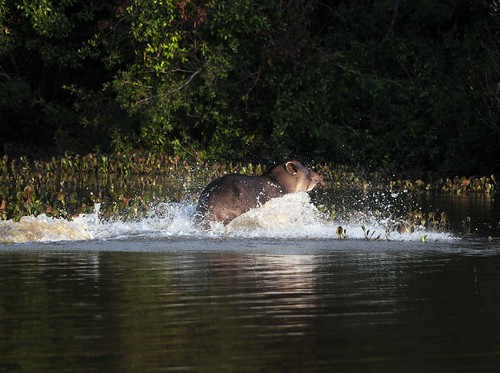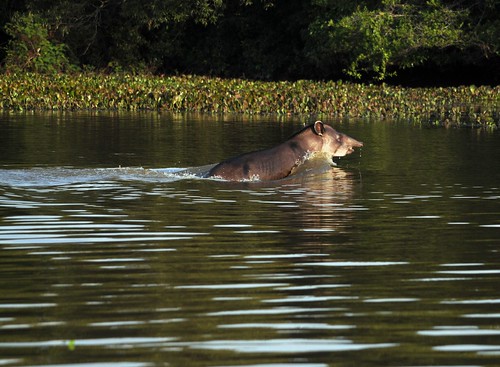This may have been the highlight of the Venezuela trip so I'll start at the beginning. We were in a boat travelling around the wetlands of Hato el Cedral (which is awesome) and with us handily were three nature guides and the sharp-sighted bus/boat driver (of whom more in later posts), one of the guides was the Hato's own Rafael and two of the guides were there to shoot photos for a field guide. Suffice it to say then we had a boatload of keen-eyed naturewise people and we were bagging up with raptors, herons, sunbittern, reptiles, wild muscovy duck, you name it we were seeing it and getting nice photos to boot when suddenly someone started screaming "tapir! tapir! tapir! go! go! go!"
Now for those of you who don't know tapirs are perissodactyls (odd-toed mammals) of which there are only about 17 or so living species. The more famous perissodactyls are the horses and the rhinoceroses and physically tapir fall somewhere between the two. They are also phenomenally difficult to see in the wild (in Venezuela at least). But sure enough amidst the confusion and shouting our driver had spotted the beast crossing the river way in front of us and was speeding towards it, I was at this point on the bow with my finger held down on the shutter of the D300 when.......the beast sounded. Now I wasn't expecting that. It was swimming fairly confidently across the river but I didn't expect it to dive as we came upon it. For a surprisingly long time the mighty beast remained submerged before finally bursting from the water very close to the boat and headed in the opposite direction to before it submerged. Spray went everywhere and we were left in no doubt that this was a big animal. Behold:


I think the coolest aspect of the whole experience came that night though. Gathered in the canteen around a laptop we shared our photos with the locals. Most of them have never seen a tapir and were absolutely amazed. Amazed but at the same time tremendously proud they had these fabulous creatures on their ranch. It was awesome.

I think you can really see the horse/rhino connection in these shots as well as the immense power of the animal. Just a pure explosion of muscle. As the beast splashed to the other side of the river, a bow wave preceding it. I knew we'd been very very lucky.

I didn't realise quite how lucky though. In the last 7 years only 3 tapirs have been seen. One of the guides with us had been guiding the area for 12 years and only seen 3. Everyone was unbelievably jubilant at seeing this weird prehistoric beast. Check out the trunk-like snout too. Unbelievable creature.
I think the coolest aspect of the whole experience came that night though. Gathered in the canteen around a laptop we shared our photos with the locals. Most of them have never seen a tapir and were absolutely amazed. Amazed but at the same time tremendously proud they had these fabulous creatures on their ranch. It was awesome.

4 comments:
Hi Tai,
You've got some spectacular photos here, and as you know, extremely rare. In most places it's very unusual to actually see tapirs in the wild even though they may be there. They tend to avoid us, although there are locations where they are seen more often than where you were.
You have most of your tapir facts right, but I wanted to clarify that there are only four species living today. The one you saw is commonly called the lowland (Brazilian, or South American) tapir. It lives in the lower elevations of most South American countries. The northern end of its range ends somewhere in Colombia near the Isthmus of Panama. The other tapir that lives in South America is the mountain tapir, which is confined to the Andes. Baird's tapir ranges from a few individuals in northern Colombia to the Yucatan in Mexico. The other species lives in Southeast Asia.
Congratulations on a rare sighting and even rarer photos! It's quite something to see the animal in its environment. I love the first shot with the splashing water. Nice camera, too :)
Sheryl Todd
President
Tapir Preservation Fund
Oops, I got so excited seeing your tapir pix that I misinterpreted what the 17 species was referring to. Anyway, you now have the lowdown on tapir species. I haven't actually counted the species of odd-toed ungulates, but if you add up the tapirs, rhinos, and horse-type animals, that's probably what it comes to. Sorry about that :)
You've got a good trigger finger, mate. Congrats on those fine action shots of one of my favorite megamammals.
Thanks both!
Sheryl - the 17 was indeed intended to be all odd-toed ungulates but I must confess I grabbed the figure online and haven't totted them up to check (I lost count at about 14!). In terms of numbers of tapir species I've heard a couple of suggestions we may see a new tapir species named soon. Do you know anything more about that?
CTC - thanks, just imagine the days when something a lot like this would've wandered past your traps in the US every now and again!
Post a Comment